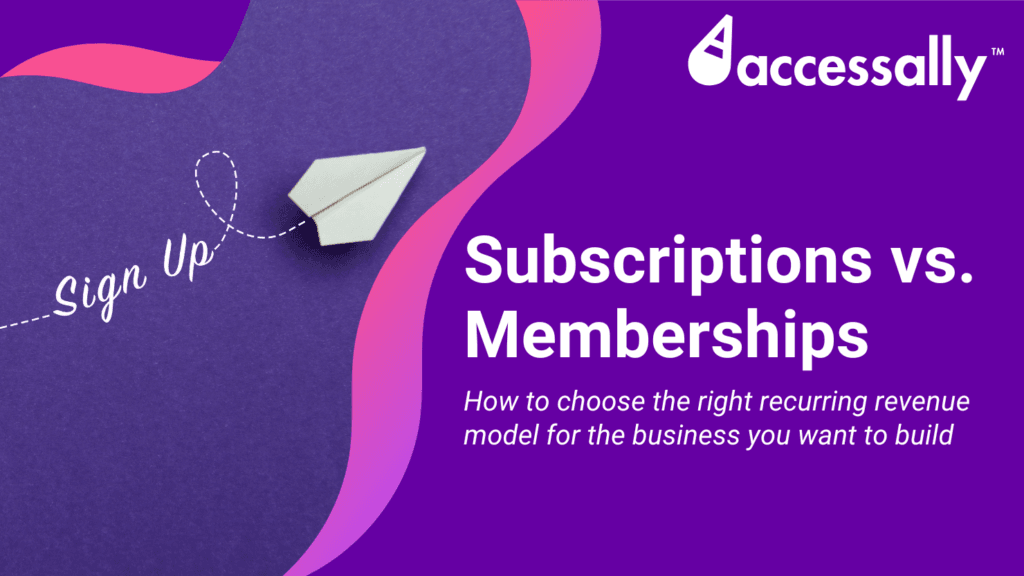People often use subscriptions and memberships as if they mean the same thing. They don’t. On the surface, both models promise recurring revenue. But that’s where the similarities end.
A subscription business and a membership business are built on very different expectations. They attract different types of customers, require different levels of ongoing involvement, and grow in very different ways over time.
Choosing the wrong model can lead to churn, burnout, or a product that never quite lives up to what people thought they were signing up for. That’s why it’s important to understand what actually separates a subscription from a membership.
In this article, we’ll break down the real differences between subscription vs membership business models, including how each one works, what your audience expects from them, and how to decide which approach (or maybe combining a bit of both) makes the most sense for your business.
Subscription vs Membership Business
Models Explained
First, let’s take a closer look at what actually defines a subscription business model vs a membership business model. This means breaking down what each one is designed to do, the purpose it serves, and how it typically shows up in real business examples.
What is a Subscription Business Model?
A subscription model is a business setup where people pay a recurring fee to consistently receive the same type of product, access, or service over time.
At its core, a subscription is about consistent delivery. People subscribe because they want reliable access to something they’ll continue to use, enjoy, or depend on over time. That “something” might be digital access, a physical product, an ongoing service, or continued use of a tool they rely on.
Subscriptions work because they remove friction. Instead of repeatedly deciding to buy, customers opt in once and continue receiving value automatically. As long as what they’re receiving remains useful or enjoyable, the subscription makes sense to keep.
Examples of Subscription Business Models:
- Content Access
Large content streaming platforms like Amazon Prime Video and Spotify are popular examples of subscriptions, where customers pay for ongoing access to an ever-growing library.
On a smaller scale, creators use this same model through regularly released content — such as podcasts, video series, blog articles, or courses — where subscribers stay enrolled to receive new material as it’s released over time.
- Software and Tools
Apps, plugins, or digital platforms that support ongoing business operations, such as design tools, writing and editing software, or SEO and analytics tools. Users keep paying because these tools continue to be useful as long as they’re part of their workflow.
- Physical Products
Recurring deliveries of physical items, including consumables like meal kits or snack boxes, as well as curated products such as skincare, household essentials, or kids’ activity kits. These subscriptions work well because they remove the need to reorder and offer convenience.
- Service Packages
Ongoing services provided on a predictable schedule, such as lawn care, cleaning services, website maintenance, or monthly retainers. Customers subscribe because they want a task handled regularly without renegotiating or rebooking each time.
In every case, the promise of a subscription is simple: pay regularly, receive regularly.
What is a Membership Business Model?
A membership model is a type of subscription where people pay a recurring fee for participation in an ongoing experience that evolves over time. The difference is what members are subscribing to.
Instead of signing up solely for content access, members join for guidance, accountability, interaction, or shared progress. They stay because the experience continues to develop — through engagement, momentum, and connection with others working toward similar goals.
Examples of Membership Business Models:
- Hobby-Based Groups
Interest-driven memberships like book clubs, crafting circles, or fitness groups where people follow a shared rhythm and gather regularly to discuss progress, ideas, or experiences related to a common hobby. - Learning Communities
Education-focused memberships that combine courses, workshops, live sessions, and discussion spaces. Members stay engaged as they move through material together and continue learning beyond a single course or event. - Coaching Groups
Ongoing coaching programs where members meet regularly for guidance, accountability, and feedback. These often include live calls, progress check-ins, and structured support that helps members apply what they’re learning over time.
Again, what ultimately sets memberships apart is that the subscription is tied to continued participation—members remain because the experience keeps unfolding as long as they’re part of it.
Shared Advantages of Both Recurring Revenue Business Models
While subscriptions and memberships differ in how they operate and what they deliver, they’re built on the same recurring revenue mechanics. That shared foundation brings a handful of advantages both models have in common:
- Steady Income
Instead of starting from zero each month, both models generate predictable revenue from active customers. That consistency makes it easier to plan ahead, manage cash flow, and make decisions without relying solely on new sales.
- Scalability
Once your systems are in place—whether that’s content delivery, fulfillment, or payment automation—both subscriptions and memberships can grow without requiring a complete rebuild each time someone joins.
- Customer Retention Over Time
When people commit to paying on an ongoing basis, the relationship naturally lasts longer than a one-time purchase. As long as value remains clear, recurring models support long-term customer relationships and repeat engagement.
The takeaway here is that either model puts your business in a strong position when it comes to building something sustainable.
The Strengths and Weaknesses of Subscription vs Membership Business Models
Before choosing between a subscription or membership model, it helps to understand what each one does well and where each can feel challenging to maintain over time.
Subscription Model Strengths
Subscriptions are often chosen because they create a straightforward way to deliver the same promise over and over again through consistent expectations, predictable delivery, and long-term manageability:
- Clear, repeatable expectations
With a subscription, people sign up knowing what they’re paying for and how often they’ll get it. Whether that’s access, a product, or a service, the agreement stays consistent from cycle to cycle, which makes the relationship easy to understand on both sides. - Built around consistency, not participation
Subscriptions don’t rely on customers showing up, engaging, or doing anything extra to get value. As long as the subscription is active, the value is delivered. That simplicity is often what makes subscriptions appealing to both buyers and business owners. - Easier to maintain over time
Because subscriptions are tied to a defined promise, they tend to be easier to keep running long-term. You’re focused on delivering the same type of value repeatedly, rather than reinventing the experience or managing ongoing interaction.
These advantages are what allow subscription models to stay stable over time, as long as the original promise continues to hold value.
Subscription Model Challenges
That same consistency that gives subscription models their stability can also create pressure over time, especially as expectations settle and options multiply:
- Keeping the value feeling worthwhile
Because subscriptions run on consistency, the biggest risk is becoming easy to ignore. If what you deliver starts to feel repetitive, outdated, or less useful, people may question why they’re still paying — even if nothing is technically “wrong”. - Subscriber churn is part of the deal
No matter how solid your offer is, some people will cancel. Needs change, budgets shift, and priorities move on. Subscriptions require you to accept churn as normal and stay focused on keeping the offer relevant for the people who remain. - Standing out in a crowded space
Subscriptions are everywhere, which makes comparison easy. If people don’t clearly understand why your offer is different or worth continuing, price and convenience can start to outweigh loyalty.
These challenges don’t make subscriptions ineffective, but they do shape how much attention it takes to keep the offer relevant and compelling as the market evolves.
Membership Model Strengths
Membership models are often chosen when the value extends beyond what’s delivered and into how people experience progress, support, and momentum together:
- A stronger sense of connection
Memberships create space for people to feel connected — not just to you, but to each other. Over time, that shared experience builds trust and familiarity, which often becomes just as valuable as the content or resources themselves. - Progress that builds over time
Memberships are well-suited for goals that don’t happen all at once. Whether it’s learning, personal growth, or staying accountable, the ongoing nature of a membership supports steady progress instead of one-off results. - Motivation through shared momentum
Being part of a group can be incredibly motivating. Seeing others show up, ask questions, or share wins helps members stay engaged and feel less alone in the process. - Built-in insight and feedback
Because members are actively involved, you naturally learn what’s working and what isn’t. Conversations, questions, and participation give you a clearer picture of what your audience needs, making it easier to evolve the experience in meaningful ways.
These strengths are what give membership models their depth — they’re designed to grow alongside the people inside them, not stay static once launched.
Membership Model Challenges
Because memberships rely on people showing up and interacting over time, the challenges tend to center on sustained involvement and leadership:
- Ongoing presence takes real energy
Memberships work best when people feel supported and seen, which usually means showing up regularly. That presence can be rewarding, but it also takes time and emotional energy, especially if the group relies heavily on you for guidance or momentum. - Keeping members engaged over time
Not everyone joins with the same level of motivation, and interest can dip as life gets busy. Creating an experience that continues to feel worthwhile without overwhelming members is an ongoing balancing act. - Managing group dynamics
As memberships grow, so do the personalities and expectations within them. Encouraging positive interaction, handling conflicts, and setting boundaries can become just as important as the content itself. - Harder to step away from
Because memberships are built around connection and participation, it’s more difficult to fully unplug or hand things off. Without careful planning, the success of the membership can feel closely tied to your personal involvement.
Running a membership means accounting for the human side of the business — where energy, attention, and consistency matter just as much as what’s being offered.
How to Decide Which Model Fits Your Business
By now, the differences between subscription and membership models should feel a lot clearer. The right choice isn’t about which model is “better” — it’s about which one fits the way you want to run your business.
Start by thinking about how you like to show up.
If you prefer a setup where value is delivered consistently without ongoing interaction, a subscription model is often the better fit. Subscriptions work well when what you offer can stand on its own and be delivered on a reliable schedule. They’re a good option if you enjoy creating something once and maintaining it over time, rather than being deeply involved with customers day to day.
If you enjoy being more hands-on, guiding people, or fostering connection, a membership model may feel more natural. Memberships are a good fit when your audience benefits from support, accountability, or shared momentum. They work best when the experience itself — not just the materials — is part of the value.
And if you’re still torn, you don’t have to choose just one.
Many businesses successfully combine both models. For example, you might offer a subscription that delivers consistent resources, alongside a membership that provides deeper support or connection for those who want it. The key is to be clear about what each offer includes so expectations stay aligned.
How One AccessAlly User Makes Subscriptions and Memberships Work Together
Staci Ann Lowry, founder of Ornament Girls, runs a business that blends a monthly subscription box with a membership experience that includes digital patterns, tutorials, and a connected community.
Each month, customers receive a physical ornament kit on a predictable schedule. At the same time, they gain access to digital resources and learning materials that build on those kits over time.


Making that kind of setup work means more than shipping boxes — it requires keeping payments, digital access, and member permissions perfectly aligned as people join, renew, or cancel.
AccessAlly allows Staci to manage both the subscription and the membership side of her business from one place. When someone signs up for a kit, their access to the matching digital content is automatically handled.
As her audience grew, this setup made it possible to deliver a consistent experience without adding unnecessary complexity behind the scenes. Members always see exactly what they should based on when they joined, what they’ve purchased, and what’s included in their subscription, while Staci stays focused on creating and growing the business instead of managing logistics.
It’s a clear example of how subscriptions and memberships can work together — and how the right system makes that combination sustainable long-term.
Final Thoughts
Whether you’re leaning toward a subscription, a membership, or a blend of both, the real challenge is running it without juggling tools, patching systems together, or spending your time fixing things that should just work.
AccessAlly gives you one place to manage payments, control access, and deliver both subscription and membership experiences without the usual friction. It’s built for businesses that want flexibility without complexity — so you can start simple, expand when you’re ready, and keep everything aligned as you grow.
If you’re ready to turn your model choice into something sustainable, now’s the time to see how AccessAlly can support it.






